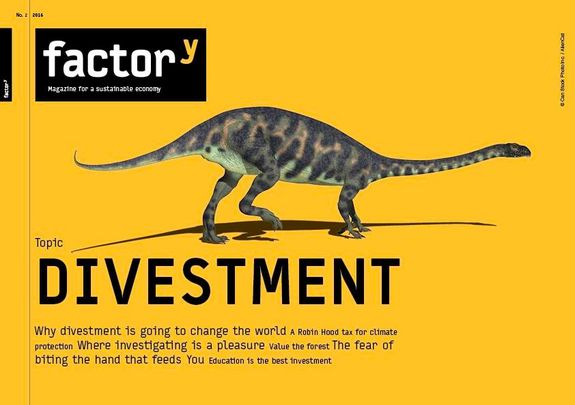Divestment

A city changes the way it invests: Münster has become the first German city to stop investing in fossil fuel generation. The divestment movement has been gaining momentum in Germany. However, the resulting decline of the fossil fuel economy also means that the municipalities that were key locations for fossil fuel economy lack funds – a change that has been particularly traumatic for Lusatia. However, with the support of federal and state governments, this does not have to spell disaster for the regional cities and villages.
By Susanne Schwarz.
Translated by Simone Kremeier, Mona Lang, Jennifer Heger, Sarah Michels, Kathryn B., Vanessa Waigum, Ella Dering, Birgit Bernhardt
A few days after Easter, Münster went about its business on the practical principle that you cannot make an omelette without breaking a few eggs. On 1 April 2016, the city’s new investment policies were put into effect. These policies established that public money can only be invested in sustainable projects, making Münster the first German city to join the divestment movement and pull its funds from environmentally harmful industries. In November 2015, Münster City Council decided to exclude all potential investments which “produce nuclear energy or do not embrace sustainability but support environmentally-harmful energy solutions.” Moreover, the city excluded investments in fracking, military weapons and child labour.
According to the Münster Municipal Treasury, this involves investments valued at around EUR 18m, which are currently spread between two different funds. When asked, City Treasurer Frank Möller did not want to reveal which companies had been financing the said funds, nor to what extent. However, other sources have pointed to institutions such as RWE as well as the Austrian and Italian energy companies OMV and Enel.
It is now up to external fund managers to decide which companies meet the new requirements. Companies that meet the exclusion criteria, such as nuclear groups and energy companies that use coal, will be removed from the list. Once these companies have been excluded, the fund managers will use the ‘best-in-class approach’: the remaining companies will be ranked and those with particularly sustainable or socially-minded business strategies will rise in the rankings.
Divestment could prompt structural change
“A total of 500 institutions worldwide have divested their environmentally-harmful investments, including 58 cities such as Oslo, Seattle and Münster”, says Tine Langkamp, divestment organiser of the climate protection organisation 350.org. This organisation has made the U.S. and international divestment movement what it is today. The group keeps exact records about where divestment decisions are being made. While no other German cities have yet followed suit – unlike the German pension institution Presseversorgungswerk and the insurance group Allianz - conversations about divesting have been taking place in various locations.
“A municipality’s decision to invest its money in sustainable instead of fossil fuel projects is certain to influence the strategy of the companies concerned”, says Daniel Vallentin, project manager of the Wuppertal Institute in Berlin and an expert on structural change in Lusatia. The region stretches from the south of Brandenburg to the east of Saxony and is home to the second largest German coalfield.
In this region, the Swedish state-owned company Vattenfall operates several lignite mines and power plants. In principle, cities should even be able to control through divestment and new sustainable investments the way in which things should proceed without coal some day. However, Vallentin doubts whether many Lusatian municipalities will actively promote structural change in this manner. He also says that they obviously – and understandably – have an interest in lignite even if they are working on structural change elsewhere.
Lignite is an economic mainstay of Lusatia. In GDR times, lignite mining was considered a national goal and even today many inhabitants still work in this field. Moreover, the municipalities are financed by local companies and the trade tax that they pay. However, business is deteriorating even without widespread divestment. The municipalities will notice this first, even before it is reflected in the electric mix.
Municipal funds for lignite are decreasing
In the past fiscal year, Vattenfall had to report figures that were even deeper in the red than in previous years. In 2015, the corporate group registered a loss of no less than EUR 2.1bn. The company had to write off EUR 3.9bn and additionally suffers from low spot electricity prices. Since the German lignite branch is one of Vattenfall’s major worries, they plan on selling it. Things are also looking bleak for the other large energy groups; RWE, E.ON and EnBW have not produced good results for years either. Fiscal revenue of the municipalities is decreasing as a result of these disastrous figures since they are dependent on the companies’ revenues.
For the year 2014, Lusatian municipalities will even have to pay back money and it is likely that this will also be the case for subsequent years. Vattenfall has already announced that the losses will probably result in halving the tax payments in 2015 for the respective municipalities and states, and in tax refunds for the years 2014 and 2016.
The exact amount is subject to fiscal secrecy. Björn Konetzke, treasurer of the town Guben situated in Brandenburgian Lower Lusatia, concedes that the sum the town has to pay back is considerable. Nearly all municipalities in the rural district of Spree-Neiße are affected. Konetzke adds that Guben may even have come off comparatively well; Spremberg, for instance, has to pay back far more. Two of Vattenfall’s world-scale plants, namely the Schwarze Pumpe power station and the Welzow-Süd surface mine, are located there. According to media reports, each municipal treasury has to pay an amount of several millions.
Konetzke remarks that it is only natural that the city treasury will suffer if trade taxes from lignite fall away. However, it is not certain that increased divestment, or even a politically established lignite phase-out would ruin Guben. Konetzke continues that it is not yet foreseeable how heavy the strain will be in the long run. Konetzke adds that there are indeed mechanisms which could be of help in dealing with such losses. There are, for example, the so-called rate support grants with which the states support the municipalities. The treasurer notes that the lower revenue could lead to higher rate support grants. This will not compensate entirely for the decreased fiscal revenue, but it will mitigate the losses.
Divestment supplements political pressure
Climate specialists have no doubt that coal and especially lignite, which is particularly harmful for the environment, has to become a thing of the past. The climate change policy is already there on a national, European and international level, says Daniel Vallentin from the Wuppertal Institute. Of course: climate targets may now exist and the global climate deal agreed upon in Paris in December 2015 has also given new impetus to the discussion. From this perspective, divestment represents an added economic pressure.
For Vallentin, it is clear: this means that Lusatia has to adapt – even if the local government of Brandenburg permitted the expansion of the opencast mine in South-Welzow as recently as 2014. But Lusatia is not completely empty-handed without coal. “The coal industry employs approximately half of the industrial workers in Lusatia – that is an extensive part, but still not everything”, claims Vallentin. “There is a chemical industry, a metal-processing industry and the food industry.” What is needed now is a schedule and a consistent policy for the district, so that people and companies can prepare and so “they don’t have to act in crisis mode later.” This is also the conclusion of a study on structural change in Lusatia, recently carried out by Vallentin and colleagues from the ‘Wuppertal Institut’ for the Green Party of Brandenburg.
“Lusatia needs a structured and systematic process that involves every stakeholder and every political level as much as possible”, says Vallentin. The people and the local authorities would have to decide for themselves what the new perspectives could be. “We deliberately didn’t recommend a particular future for Lusatia: this needs to be decided by the people who live there”, claims Vallentin.
But the new study should give them the right tools to make these decisions. Above all, the German coal regions should learn from each other, because Lusatia is not the only area having problems. “The approach used by the Rhenish Coal District sounds convincing”, says Vallentin. “The whole area was divided into eight parts, with the idea that the strength of these parts would be individually analysed and improved. Not everything will change everywhere.”
Instead of lignite: quality of life
The Rhineland is also shaped by coal economy: the coal-mining district between Cologne, Aachen and Düsseldorf is the largest one in Europe. Here, the RWE energy company runs open-pit mines and power stations. If the company is doing badly, the local authorities not only lose out on business taxes, but many of them are shareholders who are liable for the horrendous losses of the power giants. In the past, RWE dividends financed public libraries and swimming pools. This year, the company is hardly issuing a dividend for ordinary shares at all. Local authorities could find their own way out through divestment: after all, they could divert their money to other sectors that seem to be sustainable.
But all of this is still far away since it is not even a topic of discussion in many city councils. And even if it works out, coal-mining will leave its mark. You can walk for hundreds of kilometres along the dry craters of open-pit mines.
Elsewhere, citizens might complain about the sight of a wind turbine near their village, but for many Lusatians and Rhinelanders, being surrounded by a dead lunar landscape is part of their everyday life. For a long time, they accepted their situation – but if the citizens living in this destroyed environment are not even compensated with jobs and money for their own cities and villages…?
The municipalities around the Rhenish open-pit mine Inden have already looked for solutions to this problem. In January, Inden, Aldenhoven, Jülich, Eschweiler, Linnich, Langerwehe, Niederzier and the district of Düren agreed on the Masterplan Indeland 2030, a development plan for the Inden region. By the end of the next decade, they want to create the lake to be called the Indescher See – the pit will be filled with water. This will hopefully result in a better quality of life for the local residents and be an incentive for tourism.
The federal and state governments must help
There is already a similar project in Lusatia. Since 1976, former pit Restloch 117 has been a swimming lake and even more pits were flooded after the turn of the millennium. The Lusatian Lake District will continue to grow until 2030. Such projects are an important part of structural change for experts at the Wuppertal Institute. According to Vallentin, Lusatia needs more quality of life, more cultural events and more on-site educational opportunities. Then, the highly qualified people who start new businesses might come and stay. In his opinion, this is important for the Rhineland, but it is even more vital for the rural region in eastern Germany.
Restoring the environment and promoting education and culture, however, costs money that the municipalities simply do not have. The think-tank Agora Energiewende is therefore proposing a structural change fund for lignite regions. The federal government is supposed to feed this fund with an annual amount of EUR 250m. Depending on the number and location of workplaces that are dependent on lignite business, the German states would receive a certain amount which is then passed on to institutions, municipalities and projects. Only then would they be able to begin divestment and the lignite phase-out – what some would call the bare minimum for protection from climatic disaster.
Meanwhile, the German divestment movement wants to continue working towards making fossil energy production unprofitable – as long as the lignite phase-out has yet to be decided by the government. The divestment movement is optimistic, especially in the capital, where the topic was debated by the state parliament for the first time in January. Berlin's exit from fossil fuel investments would again be a German novelty, making Berlin the first state to operate a divestment policy.
Susanne Schwarz studied social sciences and philosophy in Berlin, where she now works as a journalist, among others for the online magazine klimaretter.info, the weekly newspaper der Freitag, neues deutschland and the German daily newspaper Frankfurter Rundschau.
To the desastrous impact of open lignite pit in Lusatia we recommend our fotostory "Black Gold" in the factory magazine Sisyphus for free download.
More articles to the topic of divestment, to stranded assets and to investments in renewable energies, in sustainable economy and in education there are not only online but in the factory magazine Divestment, which is ready to download. It is finely illustrated and good readable on tablets and screens and it contains all articles and pictures and even additional numbers and citations.
Themen
- The Domino Effect: the Mobility Transition as an Engine for the ‘Great Transformation’
- Cities Use the Space
- Decarbonization by 2030
- The fear of biting the hand that feeds you
- Where investing is a pleasure
- Why divestment is going to change the world
- A Robin Hood tax for climate protection
- May the Force Be with Us
- Modern Strategies
- The prerogative of interpreting the future now lies with the companies involved in climate protection”
- From Negotiating to Trading Equitably
- Can a donkey be tragic?
- Rethink rather than rebound: a sufficiency revolution must precede the efficiency revolution
- On Rebound, Prebound and Performance Gaps
- So Let Us Seize Power Then!
- With Common Property Against Political Failure
- So Let Us Seize Power Then!
- The Comforting Beauty of Failure
- “It Is Not Impossible at All.“
- Resource-light shopping
- Men Have Not Stopped Giving the Advantage to Women – So Far
- Toothpaste for Princesses and Soup for Pirates
- It is about equality
- A nice day
- Initiative instead of frustration
- The right ingredients
- Resilient for Life
- Not only, but also
- Appreciation – more please!
- Worth more than money
- Learning to value the value of goods
- Worth and Values
- The Transformative Power of Science
- Historically effective: How innovation and technology transform
- The Disappearance of Products
- Growing Older 101
- Columbus’ Egg
- It Works! In Theory at Least ...
- What If...?
- Analysing Separately – Thinking and Acting Together!
- Let’s Break Away from Determined Breaking Points
- More Gold in Waste than in Mines
- The art of separation
- Should you really DIY?
- The Aesthetics of Do-It-Yourself
- Standing on One’s Own Feet
- From the handaxe to desktop fabrication
- Using Shares to Survive the Crisis
- When Citizens participate
- Possess to Participate
- The Right Growth at the Right Time
- Gunter Pauli and Blue Economy
- When Sustainability Grows
- How we treat Growth
- Illusions about Growth


